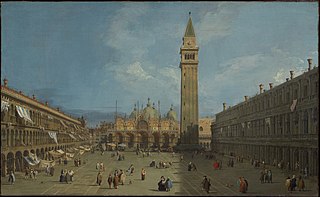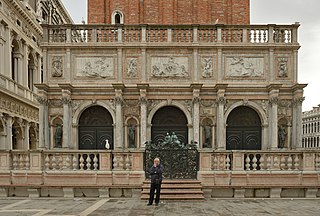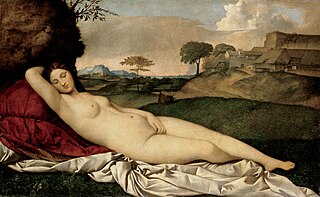
Renaissance architecture is the European architecture of the period between the early 15th and early 16th centuries in different regions, demonstrating a conscious revival and development of certain elements of ancient Greek and Roman thought and material culture. Stylistically, Renaissance architecture followed Gothic architecture and was succeeded by Baroque architecture. Developed first in Florence, with Filippo Brunelleschi as one of its innovators, the Renaissance style quickly spread to other Italian cities. The style was carried to Spain, France, Germany, England, Russia and other parts of Europe at different dates and with varying degrees of impact.

Piazza San Marco, often known in English as St Mark's Square, is the principal public square of Venice, Italy, where it is generally known just as la Piazza. All other urban spaces in the city are called campi ("fields"). The Piazzetta is an extension of the Piazza towards San Marco basin in its south east corner. The two spaces together form the social, religious and political centre of Venice and are commonly considered together. This article relates to both of them.

The Patriarchal Cathedral Basilica of Saint Mark, commonly known as St Mark's Basilica, is the cathedral church of the Roman Catholic Patriarchate of Venice; it became the episcopal seat of the Patriarch of Venice in 1807, replacing the earlier cathedral of San Pietro di Castello. It is dedicated to and holds the relics of Saint Mark the Evangelist, the patron saint of the city.

Jacopo d'Antonio Sansovino was an Italian Renaissance sculptor and architect, best known for his works around the Piazza San Marco in Venice. These are crucial works in the history of Venetian Renaissance architecture. Andrea Palladio, in the Preface to his Quattro Libri was of the opinion that Sansovino's Biblioteca Marciana was the best building erected since Antiquity. Giorgio Vasari uniquely printed his Vita of Sansovino separately.

The Procuratie are three connected buildings along the perimeter of Saint Mark's Square in Venice, Italy. Two of the buildings, the Procuratie Vecchie and the Procuratie Nuove, were constructed by the procurators of Saint Mark, the second-highest dignitaries in the government of the Republic of Venice, who were charged with administering the treasury of the Church of Saint Mark as well as the financial affairs of state wards and trust funds established on behalf of religious and charitable institutions.

St Mark's Campanile is the bell tower of St Mark's Basilica in Venice, Italy. The current campanile is a reconstruction completed in 1912, the previous tower having collapsed in 1902. At 98.6 metres (323 ft) in height, it is the tallest structure in Venice and is colloquially termed "el paròn de casa". It is one of the most recognizable symbols of the city.

The Clock Tower in Venice is an early Renaissance building on the north side of the Piazza San Marco, at the entrance to the Merceria. It comprises a tower, which contains the clock, and lower buildings on each side. It adjoins the eastern end of the Procuratie Vecchie. Both the tower and the clock date from the last decade of the 15th century, though the mechanism of the clock has subsequently been much altered. It was placed where the clock would be visible from the waters of the lagoon and give notice to everyone of the wealth and glory of Venice. The lower two floors of the tower make a monumental archway into the main street of the city, the Merceria, which linked the political and religious centre with the commercial and financial centre. Today it is one of the 11 venues managed by the Fondazione Musei Civici di Venezia.

Alessandro Leopardi was a Venetian sculptor, bronze founder and architect.

Giorgio da Sebenico or Giorgio Orsini or Juraj Dalmatinac was a Venetian sculptor and architect from Dalmatia, who worked mainly in Sebenico, and in the city of Ancona, then a maritime republic.

The Marciana Library or Library of Saint Mark is a public library in Venice, Italy. It is one of the earliest surviving public libraries and repositories for manuscripts in Italy and holds one of the world's most significant collections of classical texts. It is named after St Mark, the patron saint of the city.

Venetian Gothic is the term used for the particular form of Italian Gothic architecture typical of Venice, originating in local building requirements, with some influence from Byzantine architecture, and some from Islamic architecture, reflecting Venice's trading network. Very unusually for medieval architecture, the style is both at its most characteristic in secular buildings, and the great majority of survivals are secular.

San Giorgio Maggiore is a 16th-century Benedictine church on the island of the same name in Venice, northern Italy, designed by Andrea Palladio, and built between 1566 and 1610. The church is a basilica in the classical Renaissance style and its brilliant white marble gleams above the blue water of the lagoon opposite the Piazzetta di San Marco and forms the focal point of the view from every part of the Riva degli Schiavoni.

Mauro Codussi (1440–1504) was an Italian architect of the early-Renaissance, active mostly in Venice. The name is also rendered as Coducci. He was one of the first to bring the classical style of the early renaissance to Venice to replace the prevalent Gothic style.

The office of Procurator of Saint Mark was one of the few lifetime appointments in the government of the Venetian Republic and was considered second only to that of the doge in prestige. It was routinely occupied by nobles belonging to the most influential families and typically represented the climax of a distinguished political career, although it was often an intermediate position prior to election as doge.

The Chiesa dei Santi Apostoli di Cristo, commonly called San Apostoli, is a 7th-century Roman Catholic church located in the Cannaregio sestiere of the Italian city of Venice. It is one of the oldest churches in the city and has undergone numerous changes since its foundation. The present building is the result of a major reconstruction project which was undertaken in 1575. The church is notable particularly for the Cornaro Chapel, an important example of Early Renaissance architecture, added by Mauro Codussi during the 1490s. The chapel is the burial place of several members of the powerful Cornaro family, including Catherine Cornaro, Queen of Cyprus and Armenia. The church houses several works of art including pieces by Giambattista Tiepolo and Paolo Veronese.

The Zecca is a sixteenth-century building in Venice, Italy which once housed the mint of the Republic of Venice. Built between 1536 and 1548, the heavily rusticated stone structure, originally with only two floors, was designed by Jacopo Sansovino in place of an earlier mint specifically to ensure safety from fire and to provide adequate security for the silver and gold deposits. Giorgio Vasari considered it the finest, richest, and strongest of Sansovino's buildings.

Venetian Renaissance architecture began rather later than in Florence, not really before the 1480s, and throughout the period mostly relied on architects imported from elsewhere in Italy. The city was very rich during the period, and prone to fires, so there was a large amount of building going on most of the time, and at least the facades of Venetian buildings were often particularly luxuriantly ornamented.

Italian Renaissance domes were designed during the Renaissance period of the fifteenth and sixteenth centuries in Italy. Beginning in Florence, the style spread to Rome and Venice and made the combination of dome, drum, and barrel vaults standard structural forms.

The Loggetta is a small, richly decorated building at the base of the bell tower in Saint Mark's Square, Venice, Italy. Built by Jacopo Sansovino between 1538 and 1546, it served at various times as a gathering place for nobles and for meetings of the procurators of Saint Mark, the officials of the Venetian Republic who were responsible principally for the administration of the treasury of the Church of Saint Mark and for the public buildings around Saint Mark's Square.

The Venetian Renaissance had a distinct character compared to the general Italian Renaissance elsewhere. The Republic of Venice was topographically distinct from the rest of the city-states of Renaissance Italy as a result of their geographic location, which isolated the city politically, economically and culturally, allowing the city the leisure to pursue the pleasures of art. The influence of Venetian art did not cease at the end of the Renaissance period. Its practices persisted through the works of art critics and artists proliferating its prominence around Europe to the 19th century.




















